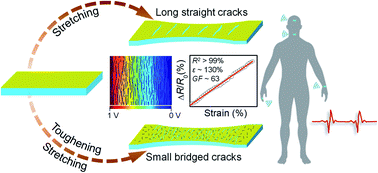Nano-toughening of transparent wearable sensors with high sensitivity and a wide linear sensing range†
Abstract
Microcracking mechanism is an effective technique for creating highly sensitive resistive strain sensors, but sensors enabled by this mechanism tend to possess a limited sensing range. Herein, we present a new method of broadening the sensing range by bridging the microcracks with conductive nano-sized fibres. The key sensing parameters such as sensitivity and linear range can be optimized by controlling the concentration of the conductive nanofibers and the plasma treatment duration of the supporting hyperelastic substrate. The experimental results reveal that our nanofiber-reinforced strain sensors, which remain highly transparent, are capable of remarkable sensitivity with a gauge factor between 22.7 and 278.1 with a linear range of 201% and 47%, respectively, significantly better than those previously reported in the literature for microcrack-based strain sensors. This exceptional improvement originates from the pulling out of the nanofibers without rupture, bridging the microcracks to prevent further growth and, thus, improving the stability of the sensors under repeated stretching. The nanofiber-reinforced strain sensors can detect both small (wrist pulse) and large (joint movements) mechanical deformations. The combined high sensitivity, linear range, and optical transparency enable this new type of sensor to be used as inconspicuous wearable devices for human motion detection and health monitoring.



 Please wait while we load your content...
Please wait while we load your content...